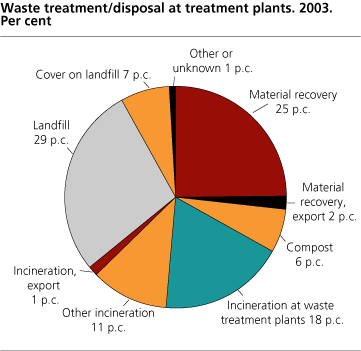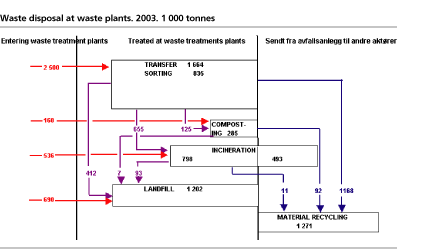Content
Published:
This is an archived release.
Waste incineration doubled in 10 years
Energy recovery increases and the amount of waste entering landfills diminishes. About 70 per cent of the energy in waste incinerated is recovered by the incineration plants, corresponding to 560 000 tonnes of waste. While the amount of waste entering incineration has doubled in the last 10 years, the amount of waste entering landfills is reduced by 30 per cent during the same time period.
| Treated by plant1 , 2. 1992-2003. 1 000 tonnes |
|
Biological
treatment |
Landfill | Incineration | |||||||||||||||||||||||||||||||||||||
|---|---|---|---|---|---|---|---|---|---|---|---|---|---|---|---|---|---|---|---|---|---|---|---|---|---|---|---|---|---|---|---|---|---|---|---|---|---|---|---|
| Total |
Energy
utilization3 |
Without
energy utilization |
|||||||||||||||||||||||||||||||||||||
| 1992 | 21 | 1 687 | 342 | 3250 | 92 | ||||||||||||||||||||||||||||||||||
| 1995 | 52 | 1 895 | 493 | 3360 | 133 | ||||||||||||||||||||||||||||||||||
| 1998 | 99 | 1 928 | 470 | 3343 | 127 | ||||||||||||||||||||||||||||||||||
| 2001 | 284 | 1 396 | 669 | 3489 | 181 | ||||||||||||||||||||||||||||||||||
| 2003 | 277 | 1 202 | 798 | 560 | 238 | ||||||||||||||||||||||||||||||||||
| 1 | Excluding waste incinerated or landfilled by industrial local units. |
| 2 | Waste for material recovery not included. |
| 3 |
Calculated from an avery energy recovery rate of 73 per cent at
Norwegian waste incineration plants. |
| Source: Statistics Norway. | |
In 2003, the total amount of waste entering Norwegian waste treatment plants was amounted to about 3.9 million tonnes. This represents approximately 50 per cent of the total waste generated in Norway. From 2001 to 2003, the amount of waste going to final disposal, i.e. landfill or incineration without energy recovery, was reduced by 9 per cent. On-site treatment in manufacturing industries is excluded from these figures.
1,3 million tonnes sorted
In general, a large amount of waste enters waste treatment in recyclable fractions. In 2003, 1.8 million tonnes came into recyclable fractions, while 2.4 million tonnes were mixed waste. Of the 550 000 tonnes mixed waste entering sorting plants, 54 per cent is sorted into recyclable fractions.
More incinerated, less landfill
In 2003, 277 000 tonnes of waste were composted, which is about 6 000 tonnes less than in 2001. The amounts incinerated increased from 674 000 tonnes to 798 000 tonnes in the same period. 1.2 million tonnes of waste were landfilled in 2003, which is 195 000 tonnes less than in 2001. On-site treatment in manufacturing industries is excluded from these figures.
The number of landfills is reduced from 112 in 2001 to 98 in 2003. In the same period, only one new incineration plant was introduced. In 2003 the number of registered incineration plants came to 21 compared with 20 in 2001.
For more information, see also Waste Accounts 2000 .
Tables:
Contact
-
Camilla Skjerpen
E-mail: camilla.skjerpen@ssb.no
tel.: (+47) 48 22 72 14
-
Mona E. Onstad
E-mail: mona.onstad@ssb.no
tel.: (+47) 48 59 61 86


